Saturday, September 30, 2006
Friday, September 29, 2006
Vacations in France
Among my friends and especially my colleagues in the US who know more about the French vacation time, the French vacation time is a wonder to behold. Normally, five weeks of vacation is due to anyone in France. In my company in France, six weeks are given to each employee after the first year.
A French Work Week
Along with the normal six weeks of vacation, the French are required to work no more than 35 hours per week. The thought is that companies will have to hire more people to accomplish the necessary work if the workforce is limited.
The Results ?
Surprisingly, I find that, despite the fewer working hours in France, the same amount of work is accomplished on both sides of the ocean. That is, American and French colleagues work together, each accomplishing project goals on time. We have multi-country teleconferences and exchange e-mail on a daily basis.
A French Workday
It is quite interesting to observe the French arrive at the office. The French arrive at the office later than Americans, after 9:00am rather than at 8:00am or before. When the French arrive, there are many handshakes among the men and kisses with the women. Everyone takes coffee and chats about the news, weather, sports, etc., nothing too personal. And after, everyone returns to their office and works very hard. There are no social exchanges until lunch.
Lunch is a very social time and everyone enjoys talking with their colleagues. The day ends about 6:00pm instead of the American 4:30pm or 5:00pm. I believe the French work harder to get the same work completed. The Americans have the luxury of more hours to complete the work.
After lunch the day is very busy with calls to the US, e-mail and such. The French are always busy and often leave the office quite late with meetings and business with the Americans.
Vacation ?
As required by French law, one must take two consecutive weeks of vacation during the time of June 1st until October 31st.
Not having taken the normal August vacation, I must tell you dear readers, that I will take my two consecutive weeks as required by law, during the first two weeks of October. I leave for Andalusia, Spain (the South of Spain) on the TGV tomorrow, Saturday 30-September.
Be well and look for another entry when I return in two weeks with many stories to tell and photographs to share.
Tuesday, September 26, 2006
"Busking" in Paris
Friday, September 22, 2006
France's TGV
This year is the 25th anniversary of the TGV or the Train à Grande Vitesse. Since the beginning of
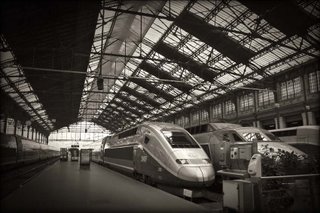 the TGV, it has made travel much easier and quicker throughout western Europe, connecting to other train systems Germany, Belgium, Italy, Switzerland and Spain. Some Americans call it the 'bullet train' of France but I have never heard it called that here. 'Bullet train' is generally a high-speed rail train especially refering to the trains in Japan.
the TGV, it has made travel much easier and quicker throughout western Europe, connecting to other train systems Germany, Belgium, Italy, Switzerland and Spain. Some Americans call it the 'bullet train' of France but I have never heard it called that here. 'Bullet train' is generally a high-speed rail train especially refering to the trains in Japan.TGV Statistics
- 100 million passengers in France and Europe in 2005
- 1.20 billion passengers since the TGV started
- 650 TGV trains run each day in France
- 250 TGV train stations
- 260 km/h (160 mph) normal high speed
- 320 km/h (200 mph) normal high speed for TGV-Est, the new TGV to Reims and Strasbourg
- 50% of travel is by TGV for less than 3 hours duration in France
- 23 billion euros in investments of infrastructure over 25 years
- 65,000 employees

- 2 of 1500 TGV drivers are women, shame !
I have traveled by TGV throughout France and find it very easy, effecient and comfortable. Living in central Paris, none of the seven major train stations are far. When I take the TGV from La Gare Montparnasse, I leave home walking 25 minutes before the trains leaves. Even then, I have enough of a margin to take my time. Most destinations in France take less than three hours. No wonder most of the French take the TGV instead of a plane for travel under three hours.
 Most often I reserve tickets via the internet via the national company SNCF and pick them up at La Gare Montparnasse at a machine. Rental cars can be picked up at destinations saving time and money.
Most often I reserve tickets via the internet via the national company SNCF and pick them up at La Gare Montparnasse at a machine. Rental cars can be picked up at destinations saving time and money.There is an even cheaper alternative than the TGV offered by a small company iDTGV. iDTGV purchases blocks of tickets for one or two TGV cars, usually just one scheduled per day. There are more restrictions but the price is worth it. The tickets are downloaded from the internet and printed on a PC / printer. Nothing could be easier or cheaper. I have paid as little as 25 euros for a fare than I have paid previously for 90 euros.
Still, in a photograph I took at Gare de Lyon, there was one unhappy traveler, stuck amid the busy travelers. Sometimes nothing works well.
Labels: TGV
Thursday, September 21, 2006
How to Speak French in Paris
 This week I ran across an article in the on-line New Yorker Magazine titled In the Waiting Room; The Advantages of Speaking French. The story is about a newly expatriated American living in Paris who abandones taking French courses because he finds it very difficult to learn French. He starts to simply respond to everything with d'accord. D'accord means I am in agreement or "OK." The author never really understands what is being said; he just says d'accord being led from one situation to another, ironically like a protagonist in a French existentialist novel. One day after saying d'accord several times at the doctor's office, the author finds himself in a doctor's waiting room in his underwear as fully dressed people enter and wait for their appointments. He has already said d'accord so he will not return to the examination room to dress and save his dignity.
This week I ran across an article in the on-line New Yorker Magazine titled In the Waiting Room; The Advantages of Speaking French. The story is about a newly expatriated American living in Paris who abandones taking French courses because he finds it very difficult to learn French. He starts to simply respond to everything with d'accord. D'accord means I am in agreement or "OK." The author never really understands what is being said; he just says d'accord being led from one situation to another, ironically like a protagonist in a French existentialist novel. One day after saying d'accord several times at the doctor's office, the author finds himself in a doctor's waiting room in his underwear as fully dressed people enter and wait for their appointments. He has already said d'accord so he will not return to the examination room to dress and save his dignity.I can really relate to this story. There are times when I absolutely understand nothing of what is being spoken in French and I need something to say.
Things to Say in French
I read another article about phrases to say the indicate that you understand, even if you do not.
- Hmmm. Ca veut dire quoi, ça ?Basically one can get the sense of the converstation and reply correctly without having understood a single word.
- Ah bon ?
- Bien sûr !
- Tout à fait.
- Voilà !
Negatively Posed Questions
There are certain words to listen for when trying to respond. The French often pose questions in the negative looking for a positive answer... "Did you not watch the soccer game ?" The answer is clear if one listens for the words "Did you not... ". The answer is always "Si, si" which means "yes indeed" or "I did so..."
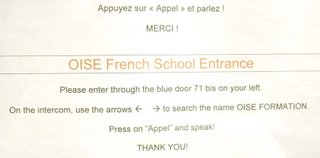 It does not matter what this means, the answer is always "Si, si", a minimum of two times and sometimes three or four times depending on the emphasis you wish to convey.
It does not matter what this means, the answer is always "Si, si", a minimum of two times and sometimes three or four times depending on the emphasis you wish to convey.Guy Talk
The other day at lunch several of the French guys were talking about their houses (of which I do not have, living in an apartment) and the kitchen upgrades in which they were engaged (yawn). I had absolutely no interest but they were nice enough to invite me to join them for lunch. I am not a real homebody and even the English words are a challenge for me.
For example... you tell me, what is the difference between a hammer, mallet, maul and gavel ? And then there are jack hammers, framing hammers, claw hammers, upholstery hammers, ball-peen hammers and club hammers. And these words are just for hammers. Well you get it. In French, speaking of the words for specific tools, how to use them and where to buy them was such a particularly specific disdiscourse that I never really understood a single word at lunch. I nodded my head said, Ah oui? and Ah...d'accord, and D'accord, je vois quite a few times but I was really thinking of my next vacation in a warm place.
Guy talk is absolutely impossible and the best possible recourse is to say d'accord.

Traps While Speaking French
D'accord is such a great answer except when responding to certain phrases. When someone asks, How ... or Why ... Tell me about ...., one cannot answer d'accord. It would not make sense. One must recognise those key words and come up with a reasonable response. This is not so easy, not having understanding the question in the beginning. I have found that I can always, shrug my shoulders, raise my hands and say bofff......, blowing out some air like the French often do and then walk away. The French like to complain and they are very cynical and sarcastic so this gesture is quite a French thing to do. The other French person will certainly understand even if you do not.
The Problem of Speaking a Little French
I am at the point where I can speak French with ease and understand 98% of something that I have done before. Buying bread, groceries, asking directions... no problem. It's a routine. The problem is that when I speak French, even with an American accent, the French think I understand French 100%. Anything out of the ordinary or new and I am totally lost.
- Bonjour madame, une baguette s'il vous plait. (simple; just a baguette. I'm speaking French !)Taking French Courses
- Oui monsieur, coupée en deux ? (ah, what ? total confusion; what the heck does that mean ?!)
- um..., um, ... ah... d'accord. (let's see if that works. If not I can always fake it and say 'boff'.)
- voilà monsieur (wow, it worked. That must mean they cut the baguette in two pieces.)
I took French courses during high school like many American students but for me the choice of taking French was mainly because the young female French Teacher was more charming and beautiful than the overweight, beer drinking, middle-aged male German Teacher.

After I began a career with a global French company, I restarted my French training, first within a group of students and coworkers and then with private tutoring. Now that I live in Paris, I continue my French lessons with a private professor. That makes more than ten years of lessons. Some of us will never learn.
Speaking French with Confidence
Confidence in speaking French is very imporant. Attitude is a key factor in interactions with the French. I certainly have advanced over the years but there are certain times when someone asks me a question very rapidly when there is a lot of noise or converstations nearby. There are times when I do not understand at all. I have a solution, however. I am confident in giving an answer and will act accordingly. I look at them straight in the eye, lean forward and I with all confidence possible, I say......... d'accord.
Labels: french, speaking french
Monday, September 18, 2006
Journées du Patrimoine, Paris; Part II
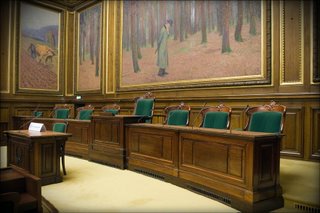 Les Journées Européennes du Patrimoine
Les Journées Européennes du PatrimoineSunday was overcast and cool and therefore a perfect day to visit another grand building, monument or site during the two-day Journées Européennes du Patrimoine, or European Heritage days in 
Le Palais Royal
The first noted residence of what would later become Le Palais Royal situated near the Louvre, was Cardinal Richelieu in 1624. This grand building is the site of many famous residents ever since. Now the home of the Minister of Culture and Communications, Le Palais Royal opens it's doors to the people of  and new modern paintings and sculptures.
and new modern paintings and sculptures.
The Offices of the Palais Royal
Several of the conference rooms were dedicated to the Department of Finance and libraries that were certainly less elaborate and more functional. Most of the offices and desks were clean of papers and books but I had to laugh at a large office of workers with paper, books and references stacked everywhere. Certainly the French bureaucracy lives as it does in every government.
Labels: Palais Royal
Saturday, September 16, 2006
Journées du Patrimoine, Paris; Part I
Each year in September, for one weekend, the governments of European nations open the doors to buildings, monuments and sites to the public, many of which are not normally accessible to the public.
 The thought is to widen access to the government and foster good will among the people of the nation. This event, Journées Européennes du Patrimoine, European Heritage Days or Doors Open Days, started in France in 1984 and spread to other European nations over the years. Other nations even on other continents are sponsoring similar events.
The thought is to widen access to the government and foster good will among the people of the nation. This event, Journées Européennes du Patrimoine, European Heritage Days or Doors Open Days, started in France in 1984 and spread to other European nations over the years. Other nations even on other continents are sponsoring similar events.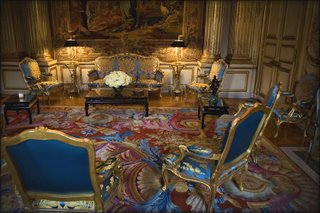
This year was the third year I was able to enjoy this grand event, sponsored by the Ministre de Culture. Memorable visits have included visiting the once-per-year opening of the Sénat de France, Manufacture des Gobelins de Beauvais et de la Savonnerie (hand woven carpets in the ancient tradition), Opéra, Hotel de Sens. Each visits offers a special look at France and it's culture.
Palais de l'Elysée
Last year the thought crossed my mind that to visit the Palais de l'Elysée would be excellent.
 Palais de l'Elysée is the residence and offices of the President of France, Jaques Chirac. This thought must have crossed the minds of many hundreds of other people's minds last year and much before I arrived at the line end of the line it streched as far as I could see. The guard said it was too late to visit.
Palais de l'Elysée is the residence and offices of the President of France, Jaques Chirac. This thought must have crossed the minds of many hundreds of other people's minds last year and much before I arrived at the line end of the line it streched as far as I could see. The guard said it was too late to visit.This year I planned ahead, I rose early and arrived at the line at 8:20am. The tour started at 10:00am giving me plenty of time. Of course there was already a crowd in line and I walked to the end of the line. Walking to the end of the line took over ten minutes. The wait in line to the front door was three and a half hours.

In the end, the visit was worth the wait as one can see from the photos.
 Most impressive was the State Dining room with a large table dwarfed by the immensity of a the dining room surrounded by curtains with a huge painted ceiling above. The table was perfectly set, chairs removed for the visitors to have a perfect view. Chandeliers hung from the ceiling high above.
Most impressive was the State Dining room with a large table dwarfed by the immensity of a the dining room surrounded by curtains with a huge painted ceiling above. The table was perfectly set, chairs removed for the visitors to have a perfect view. Chandeliers hung from the ceiling high above.Hotel de Marigny
Hotel de Marigny is the residence of visiting foreign states of head or other dignitaries.
 Hotel de Marigny is located directly across the street from the Palais de l'Elysée so those foreign dignitaries need not take the long motorcades across Paris. I was impressed by the luxury of the Hotel. Remember that Hotel once meant hostel since there was not really the concept of traveling like one does today. Hotels were permanent residences that sometimes hosted travelers.
Hotel de Marigny is located directly across the street from the Palais de l'Elysée so those foreign dignitaries need not take the long motorcades across Paris. I was impressed by the luxury of the Hotel. Remember that Hotel once meant hostel since there was not really the concept of traveling like one does today. Hotels were permanent residences that sometimes hosted travelers.Hotel de Beauvau
Hotel de Beauvau is the residence of the Secretary of the Interior, one of the most important posts in the French government. The post is currently held by the conservative Nicolas Sarkosky who is very popular and likely the next president of France. I did not take a photgraph of "Sarko's" desk. No computer was visible.
The Hotel de Beauvau is quite large, not as elegant as either Hotel de Marigny or certainly the Palais de l'Elysée. There are many bureaucratic offices and functional rooms, without interest. Interestingly during World War II, there were interrogation rooms for French resistance fighters. Hotel de Beauvau was taken over by the Germans during WWII for their use, particularly by the German Gestapo.
Labels: Palais de l'Elysée
Tuesday, September 12, 2006
Cemetary Père Lachaise, Paris
Irrespectively of our religious thoughts, there are the practical matter of where we put our dead. Different cultures and places in the world deal with this necessity differently. Paris, being more than two millennium old, in no exception.
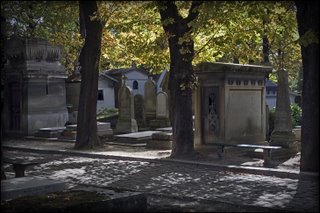
There is something intriguing to everyone about the old cemeteries in Paris. I recently bought a guide to summer walks in Paris and among the suggestions of parks and green spaces there were the cemeteries. There are 14 marked cemeteries within the city limits. I say marked because there are certainly more cemeteries that have been built upon or forgotten. Not forgotten are the Catecombs of Paris, those underground caves carved into the limestone over the centuries to keep the remains of millions of Parisians, but the Catecombs are for another story.
Le Cimetière du Père Lachaise in Late Summer
Last Sunday, after being inspired by my adventure in the Cimètaire de
 Montparnasse on Friday, I ventured to La Cimetière du Père Lachaise for the sunny afternoon, taking Métro line 6 from Montparnasse to Nation then line 2 to station Philippe Auguste in the 20th. The leaves are starting to turn yellow in many of the trees and families were strolling with babies in carriages along the cobblestone lanes. To me it seemed a dichotomy to enjoy such a pleasant afternoon among thousands of dead. And who were they, the tens of thousands resting here ? Certainly many are or were quite famous and known throughout the world in their time and indeed our own.
Montparnasse on Friday, I ventured to La Cimetière du Père Lachaise for the sunny afternoon, taking Métro line 6 from Montparnasse to Nation then line 2 to station Philippe Auguste in the 20th. The leaves are starting to turn yellow in many of the trees and families were strolling with babies in carriages along the cobblestone lanes. To me it seemed a dichotomy to enjoy such a pleasant afternoon among thousands of dead. And who were they, the tens of thousands resting here ? Certainly many are or were quite famous and known throughout the world in their time and indeed our own.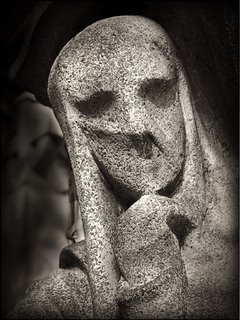
Death and Decay
 Some
Some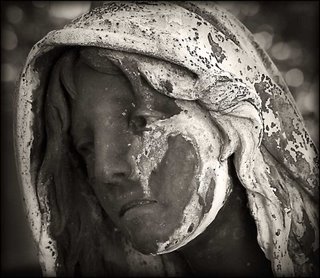 one once built
one once built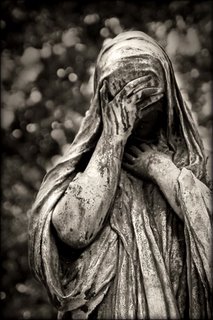 stately monuments, tombs, statues for their loved ones. Obviously those who did so follwed and are gone as well. The generations who followed were more and more removed.
stately monuments, tombs, statues for their loved ones. Obviously those who did so follwed and are gone as well. The generations who followed were more and more removed.Walking through a grand cemetery such as Père Lachaise makes me think of my own mortality and the certainty of my death, then years later of me being forgotten. Death and eventually being forgotten will happen to everyone after dozens, hundreds or thousands of years. These macabre photos are my interpretation of that eventuality.
Saturday, September 09, 2006
Paris Left Bank Shops
This evening I walked along the rue de Vaugirard towards the Seine, taking a turn to rue du Cherche-Midi and walked by the original location of the famous bakery Poilâne.
 Pierre Poilâne opened this bakery in 1932 at No. 8 rue du Cherche-Midi in the Saint Germain des Prés district of Paris. Pierre made a dense, stone-ground whole wheat bread with natural fermentation and baked in a wood-fired baking oven. Even after WWII, Pierre Poilâne continued his rustic craft despite the fact that white bread was much in fashion.
Pierre Poilâne opened this bakery in 1932 at No. 8 rue du Cherche-Midi in the Saint Germain des Prés district of Paris. Pierre made a dense, stone-ground whole wheat bread with natural fermentation and baked in a wood-fired baking oven. Even after WWII, Pierre Poilâne continued his rustic craft despite the fact that white bread was much in fashion.The production of Poilâne bread was much expanded after Pierre's son Lionel took over the business in the 1970s. Today, the sourdough bread can be found in many supermarkets and restaurants throughout Paris but we Parisians find the little original bakery a delightful place to buy the famous bread.
La Fromagerie Barthélemy
There are other small shops in the Saint Germain des Prés
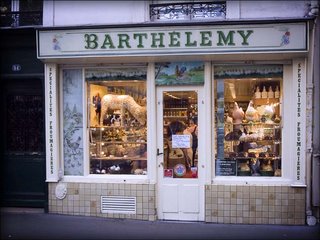 area, such as the fromagerie Barthélemy at 51, rue de Grenelle, 75007 Paris run by Roland Barthélemy. Although he does not have a website for the fromagerie, or 'cheese shop', many references of Fromagerie Barthélemy can be found by searching Google. One reference quoted an American...
area, such as the fromagerie Barthélemy at 51, rue de Grenelle, 75007 Paris run by Roland Barthélemy. Although he does not have a website for the fromagerie, or 'cheese shop', many references of Fromagerie Barthélemy can be found by searching Google. One reference quoted an American..."The clever cat eats cheese and breathes down rat holes with baited breath."
W. C. Fields (1880-1946),
American comic and actor
There are other little boutiques that appear to be quite small and family run but are part of a large network.
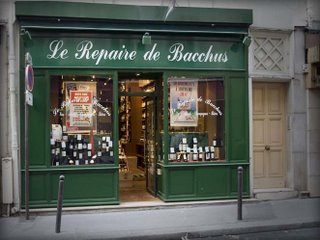 An example is Le Repaire de Bacchus on 74 rue de Grenelle. Although one can certainly buy wine on-line and have it delivered, I find it interesting to buy in the little store.
An example is Le Repaire de Bacchus on 74 rue de Grenelle. Although one can certainly buy wine on-line and have it delivered, I find it interesting to buy in the little store.Labels: baguette, boulangerie, fromagerie, paris, rive gauche
Friday, September 08, 2006
Montparnasse Cemetary, Paris
 This late afternoon, however, I decided to visit a part of Montparnasse that is quite the opposite and quite literally dead.
This late afternoon, however, I decided to visit a part of Montparnasse that is quite the opposite and quite literally dead.The Cemetary of Montparnasse was established in 1824 from three farms outside and to the south of Paris. Since that time, Paris has grown and the boundaries have overcome and passed the cemetery. Other cemeteries are found in Paris such as Père Lachaise in the northeast of Paris which is larger and perhaps more known to Americans.

Cemetery Montparnasse is the final resting place of many of the world's intellectual and artistic elite such as Jean-Paul Sartre, Simon de Beauvoir, Samuel Beckett, Serge Gainsbourg, Susan Sontag, Antoine Bourdelle and many others. The many tombs, both old and new are facinating and in the late afternoon light took on a depth that lead to some interesting photographs.
 There were other people visiting the Cemetery elderly people, caretakers of children and their young, tourists and those just seeking solitude among the tombs.
There were other people visiting the Cemetery elderly people, caretakers of children and their young, tourists and those just seeking solitude among the tombs.Marble and granite were predominate with many large family burial places. Often flowers both real and artificial were left. To me, the statues were the most interesting.
Guards signal the closure of the cemetery by using police whistles as they walk along the main paths. When I heard the whistles fifteen minutes before the official closure at 6pm, I walked to the nearest exit but found the gates already closed by lock and key. I found a guard and we discussed the beauty of the cemetary as he walked with me to an open gate.
Labels: cemetary, Montparnasse



